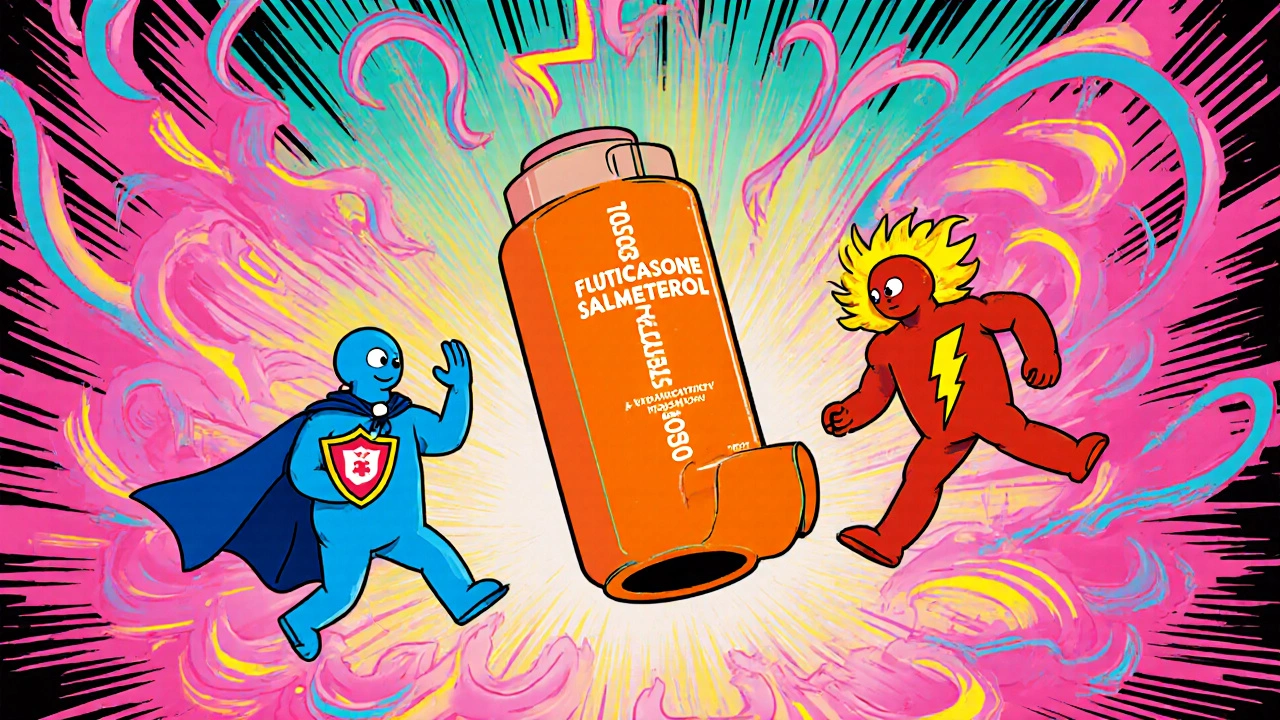Fluticasone-Salmeterol Drug Interaction Checker
Check Your Medications
Enter the medications you're currently taking to check for potential interactions with fluticasone-salmeterol.
When you pick up an inhaler labeled fluticasone‑salmeterol, you’re holding a combination drug that tackles two major problems in asthma and COPD at once: inflammation and airway narrowing. Fluticasone‑salmeterol is a fixed‑dose inhaled medication that pairs an inhaled corticosteroid (ICS) with a long‑acting β2‑agonist (LABA). The science behind this pairing is what keeps symptoms under control for many patients.
Why Combine Two Drugs in One Inhaler?
Asthma isn’t just occasional wheezing; it’s a chronic inflammatory disease that makes the airways swell, produce mucus, and become overly sensitive to triggers. Corticosteroids like fluticasone suppress the immune response, reducing swelling and mucus. Meanwhile, bronchodilators such as salmeterol relax the smooth muscle around the bronchi, widening the airways and making breathing easier. By delivering both in a single inhaler, doctors guarantee patients get the anti‑inflammatory punch and the lasting bronchodilation they need without juggling multiple devices.
Fluticasone: The Anti‑Inflammatory Powerhouse
Fluticasone propionate, the corticosteroid component, works by binding to glucocorticoid receptors inside airway cells. Once bound, it alters gene transcription, turning down the production of pro‑inflammatory cytokines like interleukin‑5 and tumor necrosis factor‑α. The net effect is fewer eosinophils, less mucus, and a calmer airway lining. Because it’s inhaled, the drug acts directly where it’s needed, and systemic exposure stays low, limiting typical steroid side effects.
Salmeterol: The Long‑Acting Bronchodilator
Salmeterol xinafoate belongs to the LABA class. It attaches to β2‑adrenergic receptors on airway smooth muscle, triggering a cascade that raises cyclic AMP (cAMP) levels. Higher cAMP relaxes the muscle fibers, keeping the airway open for up to 12 hours. Salmeterol’s onset is slower than short‑acting bronchodilators, but its durability is perfect for maintenance therapy.
How the Two Molecules Interact
The synergy between fluticasone and salmeterol isn’t just additive; it’s partly reciprocal. When salmeterol opens the airways, it improves the penetration of fluticasone deeper into the lung tissue. Conversely, the anti‑inflammatory action of fluticasone reduces the airway remodeling that can blunt the responsiveness to β2 agonists over time. This bidirectional boost is why the fixed‑dose combo often outperforms using each drug alone.
Delivery System: Dry Powder Inhaler (DPI)
Most fluticasone‑salmeterol products come in a DPI, which releases a fine powder when the patient inhales forcefully. The device is breath‑actuated, meaning there’s no propellant and the dose is inhaled directly into the lungs. Proper technique-slow, deep inhalation followed by a breath hold-ensures the medication reaches the lower airways where it’s most needed.

Pharmacokinetics: Absorption, Metabolism, and Excretion
After inhalation, about 10‑20% of the fluticasone dose reaches the systemic circulation; the rest stays lodged in the airway tissue. Fluticasone is metabolized primarily by cytochrome P450 3A4 (CYP3A4) in the liver, producing inactive metabolites that are excreted via the feces. Salmeterol’s systemic absorption is also modest, with roughly 15% reaching the bloodstream. It’s similarly broken down by CYP3A4, so drugs that inhibit this enzyme (e.g., ketoconazole) can raise salmeterol levels and increase the risk of side effects.
Clinical Efficacy: What the Studies Show
Large‑scale trials such as the TORCH and SUMMIT studies have demonstrated that fluticasone‑salmeterol reduces exacerbations, improves lung function (FEV1), and lowers the need for rescue inhalers in both asthma and COPD patients. In asthma, the combination lowered the rate of severe attacks by about 30% compared with placebo. For COPD, it slowed the decline in lung function over three years, proving its value as a maintenance therapy.
Safety Profile and Common Side Effects
Because the drug is inhaled, most side effects are local: hoarseness, oral thrush (candidiasis), and coughing after use. Rinsing the mouth with water and spitting out the rinse can prevent fungal growth. Systemic side effects like adrenal suppression are rare but can occur at high doses or with prolonged use. Salmeterol carries a boxed warning about the risk of asthma‑related death when used without an accompanying corticosteroid, reinforcing why the combo is essential.
Drug Interactions to Watch
- Strong CYP3A4 inhibitors (ketoconazole, itraconazole, ritonavir) can raise plasma levels of both components, potentially increasing side effects.
- Ritonavir‑boosted therapies used in HIV can have a similar effect.
- Beta‑blockers may blunt salmeterol’s bronchodilatory action.
- Diuretics can enhance the risk of hypokalemia when combined with high‑dose LABAs.

Choosing the Right Dose
Fluticasone‑salmeterol is available in two main strengths: 100/50 µg (low dose) and 250/50 µg (high dose) per inhalation. The low dose is usually prescribed for patients with mild‑to‑moderate asthma, while the high dose is reserved for those with more severe disease or frequent exacerbations. Doctors base the choice on symptom control, lung‑function tests, and the patient’s history of exacerbations.
Tips for Getting the Most Out of Your Inhaler
- Shake the inhaler gently before each use.
- Exhale fully, then inhale quickly and deeply through the mouthpiece.
- Hold your breath for about 10 seconds to allow the powder to settle.
- Rinse your mouth with water and spit out after each dose.
- Store the inhaler at room temperature, away from moisture.
Comparing the Two Components
| Attribute | Fluticasone Propionate (ICS) | Salmeterol Xinafoate (LABA) |
|---|---|---|
| Drug class | Inhaled corticosteroid | Long‑acting β2‑agonist |
| Primary action | Reduces airway inflammation | Relaxes airway smooth muscle |
| Onset of effect | Hours (anti‑inflammatory) | 5‑15 minutes |
| Duration | 12‑24 hours (maintenance) | 12 hours |
| Typical inhaled dose | 100 µg or 250 µg per actuation | 50 µg per actuation |
| Metabolism | CYP3A4 (liver) | CYP3A4 (liver) |
| Common side effects | Oral thrush, hoarseness | Tremor, palpitations |
When to Seek Medical Advice
If you notice worsening breathlessness, frequent use of rescue inhalers, or signs of oral thrush that don’t improve with rinsing, contact your doctor. Unexplained heart palpitations, tremors, or severe allergic reactions (rash, swelling) also warrant immediate attention. Because the combo contains a LABA, never stop using it abruptly; tapering under medical supervision prevents rebound bronchospasm.
Future Directions: New Formulations on the Horizon
Researchers are exploring ultra‑fine particle formulations that could improve deep‑lung delivery, and smart inhalers that track usage via Bluetooth to help patients and clinicians monitor adherence. While the core science of fluticasone‑salmeterol remains solid, these innovations aim to make therapy even more effective and user‑friendly.
How quickly does fluticasone‑salmeterol start working?
Salmeterol begins relaxing the airway within 5‑15 minutes, while fluticasone’s anti‑inflammatory effects build over several hours. Full benefit is usually seen after a few days of regular use.
Can I use a spacer with my fluticasone‑salmeterol DPI?
No. The dry‑powder inhaler is breath‑actuated and requires a fast, deep inhalation. A spacer is only compatible with metered‑dose inhalers (MDIs).
Is it safe to use fluticasone‑salmeterol during pregnancy?
Inhaled corticosteroids are generally considered low‑risk, but any medication during pregnancy should be discussed with a healthcare provider. The benefits of controlling asthma often outweigh potential risks.
What should I do if I miss a dose?
Take the missed dose as soon as you remember, unless it’s almost time for the next scheduled inhalation. In that case, skip the missed dose and continue with your regular schedule. Never double‑dose.
Can fluticasone‑salmeterol be used for acute asthma attacks?
No. This combo is a maintenance medication. For sudden flare‑ups, a short‑acting bronchodilator (e.g., albuterol) is required for rapid relief.

Mary Keenan
Honestly, most people just pop the combo inhaler without ever learning the proper technique.
Marrisa Moccasin
It's obvious the pharma giants are secretly embedding micro‑chips in those inhalers to track our breathing patterns!!!
Ritik Chaurasia
Let me break down why fluticasone‑salmeterol is a game‑changer for millions of asthma sufferers, especially in South Asia where air quality can be terrible. The corticosteroid component, fluticasone, tackles the root inflammatory process that makes airways hyper‑reactive. By binding to glucocorticoid receptors, it down‑regulates cytokine production, which in turn reduces eosinophil recruitment. This is crucial because eosinophilic inflammation drives many of the severe attacks we see in hot, humid climates. The LABA part, salmeterol, provides a long‑lasting bronchodilatory effect that keeps the airways open for up to twelve hours, which aligns well with typical waking‑sleep cycles. When you inhale the powder, the fast‑acting salmeterol opens the passages, allowing the steroid to penetrate deeper into the lung tissue. This reciprocal relationship boosts overall efficacy beyond what either drug could achieve alone. Clinical trials such as TORCH and SUMMIT have confirmed a roughly 30% reduction in severe exacerbations compared to placebo, which is a massive public‑health win. Moreover, the DPI delivery system eliminates the need for propellants, making it environmentally friendlier – an aspect that resonates with Indian sustainability goals. Metabolism via CYP3A4 means that patients on strong inhibitors need dose adjustments, a detail often overlooked in primary care. Side‑effects remain largely local – oral thrush and hoarseness – which can be mitigated with simple mouth‑rinse practices. Systemic absorption is low, so adrenal suppression is rare but still worth monitoring in high‑dose regimens. The combination also reduces reliance on rescue inhalers, cutting down overall medication costs for families. In rural settings, where access to multiple inhalers is limited, a single device simplifies adherence and reduces confusion. Patient education on technique – a deep, forceful inhalation followed by a breath‑hold – is vital for optimal deposition. Lastly, ongoing research into ultra‑fine particles and smart inhaler technology promises even greater control and data‑driven management in the near future.
Steven Young
While the combination inhaler offers clear benefits, it's essential to remember that improper use can negate its advantages. Rinsing the mouth after each dose prevents fungal overgrowth, and patients should avoid abrupt discontinuation to prevent rebound bronchospasm. Monitoring for signs of systemic steroid exposure, though rare, remains a prudent practice.
Kelly Brammer
Indeed, patient education is a moral duty; neglecting it borders on negligence, especially when simple steps can avert complications.
Holly Green
Just remember: shake the inhaler gently, inhale fast and deep, hold for ten seconds, and rinse – simple steps, big difference.
Craig E
We often overlook how the act of breathing itself becomes a ritual of hope when you master the inhaler technique; it transforms a mechanical process into a mindful moment of self‑care, echoing the ancient practice of breath awareness.
Taylor Haven
The poetic nature of controlled breathing shouldn't be dismissed as mere superstition; it serves as a subtle reminder that even pharmaceutical interventions are intertwined with our conscious engagement, and acknowledging this synergy can empower patients to take ownership of their treatment journey, reducing the covert manipulation often hidden behind clinical directives.
Sireesh Kumar
Honestly, the whole thing feels like drama – you get a fancy inhaler, then they tell you to do a complicated dance with it, but if you just follow the steps you’ll be fine.
Jonathan Harmeling
It's vital to respect the science while also recognizing that every patient’s experience is unique, and the blend of fluticasone and salmeterol should be tailored with compassion and precision.
Kelli Benedik
Totally feel you 🌟 – the combo is powerful, but you gotta stay on top of those mouth‑rinses, or else the thrush sneaks in 😱.
cariletta jones
Optimism + proper technique = fewer flare‑ups, simple math!
Caleb Clark
Alright folks, listen up – you want results? Then DO the thing. First, make sure your inhaler is not crammed in a drawer where dust gathers. Next, give it a quick shake – not a vigorous one, the kind that makes you look like you're mixing a cocktail – just a gentle swirl. When you take a puff, do it with a big breath, like you’re inflating a balloon, hold it for a solid ten seconds, then exhale slowly. Don’t forget that after each dose, rinse out your mouth with water and spit, no swallowing! If you skip any of those steps, you’re basically throwing money away on a device that won’t work as intended. Trust me, I’ve seen too many folks waste their meds because they didn’t care about the basics. Stay consistent, track your usage, and you’ll notice fewer rescue inhaler calls. And hey, if something feels off, call your doc sooner rather than later – early tweaks save big headaches down the road.
Gary Marks
Look, the whole combo inhaler scene is a circus of marketing and half‑baked promises – sure, fluticasone‑salmeterol can help, but only if you actually read the fine print, follow the proper inhalation technique, and stay vigilant about side‑effects; otherwise, you’re just another pawn in the pharmaceutical game, coughing away your savings while the big players count their profits.